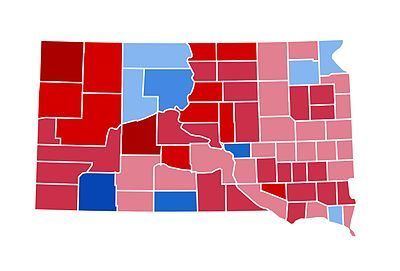3 0 59.9% 38.4% | 232,584 149,244 Start date November 2, 2004 | |
 | ||
The 2004 United States presidential election in South Dakota took place on November 2, 2004 throughout all 50 states and D.C., which was part of the 2004 United States presidential election. Voters chose 3 representatives, or electors to the Electoral College, who voted for President and Vice President.
Contents
- Primaries
- Predictions
- Polling
- Fundraising
- Advertising and visits
- Analysis
- By congressional district
- Electors
- References
South Dakota was won by incumbent President George W. Bush by a 21.5% margin of victory. Prior to the election, all 12 news organizations considered this a state Bush would win, or otherwise considered as a safe red state. Since 1940, the state has voted for the Republican nominee in every Presidential election, except 1964.
Primaries
Predictions
There were 12 news organizations who made state by state predictions of the election. Here are their last predictions before election day.
- D.C. Political Report: Solid Republican
- Associated Press: Solid Bush
- CNN: Bush
- Cook Political Report: Solid Republican
- Newsweek: Solid Bush
- New York Times: Solid Bush
- Rasmussen Reports: Bush
- Research 2000: Solid Bush
- Washington Post: Bush
- Washington Times: Solid Bush
- Zogby International: Bush
- Washington Dispatch: Bush
Polling
Bush won every pre-election by a double digit margin. The final 3 poll average showed Bush with 55% to Kerry at 39%.
Fundraising
Bush raised $399,805. Kerry raised $71,553.
Advertising and visits
Neither campaign advertised or visited this state during the fall campaign season.
Analysis
South Dakota politics are generally dominated by the Republican Party, and the state has not supported a Democratic presidential candidate since 1964 — even George McGovern, the Democratic nominee in 1972 and himself a South Dakotan, did not carry the state. Additionally, a Democrat has not won the governorship since 1978. As of 2006, Republicans hold a 10% voter registration advantage over Democrats and hold majorities in both the state House of Representatives and Senate.
Despite the state's general Republican and conservative leanings, Democrats have found success in various statewide elections, most notably in those involving South Dakota's congressional representatives in Washington. Two of the three current members of the state's congressional delegation are Democrats, and until his electoral defeat in 2004 Senator Tom Daschle was the Senate minority leader (and briefly its majority leader during Democratic control of the Senate in 2001–02).
By congressional district
Due to the state's low population, only one congressional district is allocated. This district, called the At-Large district, because it covers the entire state, and thus is equivalent to the statewide election results.
Electors
Technically the voters of SD cast their ballots for electors: representatives to the Electoral College. SD is allocated 3 electors because it has 1 congressional districts and 2 senators. All candidates who appear on the ballot or qualify to receive write-in votes must submit a list of 3 electors, who pledge to vote for their candidate and his or her running mate. Whoever wins the majority of votes in the state is awarded all 3 electoral votes. Their chosen electors then vote for President and Vice President. Although electors are pledged to their candidate and running mate, they are not obligated to vote for them. An elector who votes for someone other than his or her candidate is known as a faithless elector.
The electors of each state and the District of Columbia met on December 13, 2004 to cast their votes for President and Vice President. The Electoral College itself never meets as one body. Instead the electors from each state and the District of Columbia met in their respective capitols.
The following were the members of the Electoral College from the state. All 3 were pledged for Bush/Cheney.
- Dennis Daugaard
- Larry Long
- Mike Rounds
